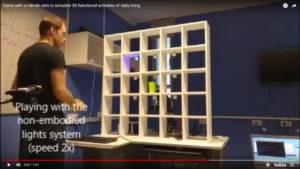
This Rehab Robot Challenges You to Tic-Tac-Toe
This Rehab Robot Challenges You to Tic-Tac-Toe
May 7, 2018
By Evan Ackerman, a Fromson Fellow on the 2017 Murray Fromson Journalism Fellowship.
IEEE Spectrum – Physical rehabilitation is not something that anyone does for fun. You do it grudgingly, after an illness or accident, to try and slowly drag your body back toward what it was able to do before. I’ve been there, and it sucks. Rehab was hard and boring, so I didn’t properly finish it.
Researchers at Ben-Gurion University of the Negev in Israel, led by Dr. Shelly Levy-Tzedek of BGU’s Department of Physical Therapy and Zlotowski Center for Neuroscience, have designed a friendly robot arm that can play a mediocre game of tic-tac-toe with you, using cups placed inside a 3 x 3 square of shelving. While you’re focused on beating the robot, you’re also doing repetitive reaching and grasping, gamifying all of that upper-limb rehabilitation and making it suck a whole lot less.
Using cups was a deliberate choice, because grasping cups is one of those functional movements related to activities of daily living that rehab focuses on restoring.
In this study, there were two groups of participants, an older and a younger group. The participants were given an option of playing tic-tac-toe with the robot arm and then with a light-up board. Everyone preferred playing with the robot, at least for the first few games, but when asked to play lots of games in a row, the younger group changed their preference to playing with the light-up board instead, because it’s quicker. The older folks didn’t care as much. Everyone also agreed that if they had to pick one system to take home, it would be the robot.
Using this system for rehab has a few other advantages beyond just making rehab more fun. For example, the system could recognize that you’re having a bit of trouble reaching for specific spots on the board, and change where it places its pieces to either encourage you to keep working on the range of motion required to reach those spots, or give you a bit of a break by making it easier to reach certain spots.
Below is an excerpt of an interview with Dr. Shelly Levy-Tzedek.
Can you describe how the design of the game is useful for rehabilitation?
Patients after stroke often lose the ability to perform certain everyday activities, such as picking up a cup to drink from. We developed a game with a robotic partner, where, in order to win the game, the participants have to pick up and place a cup many times over. Thus, they end up performing the repetitive (otherwise boring) task that is required in rehab, but in a fun, engaging setup, and with the ability to track their performance during training.
What other rehabilitation games can a system like this be used for?
We have also used this robotic arm to play the “mirror game,” in which one partner (the person or robot) is leading, and the other is following its movements in space, and then they reverse roles. The robot can incrementally increase the extent of the movement that it performs, with the person following it closely.
In general, how could robots be a useful addition to traditional kinds of rehabilitation therapy?
Robots offer several benefits when used in addition to traditional therapy. They can help in performing repetitive training for many patients without tiring, and can help increase the motivation of patients to perform their exercise regime, which is currently a major problem in rehab. Patients need to perform a lot of self-training, but the compliance rates can be as low as 30 percent. So people are not getting the amount of exercise they need, and motivation plays a big role in this. Gamifying the exercise routine offers an opportunity to increase engagement, and hopefully improve the clinical outcome of patients. Robots can come into the gap in between appointments with the therapist, and help increase the volume of the exercise.
Read more on the IEEE Spectrum website >>




